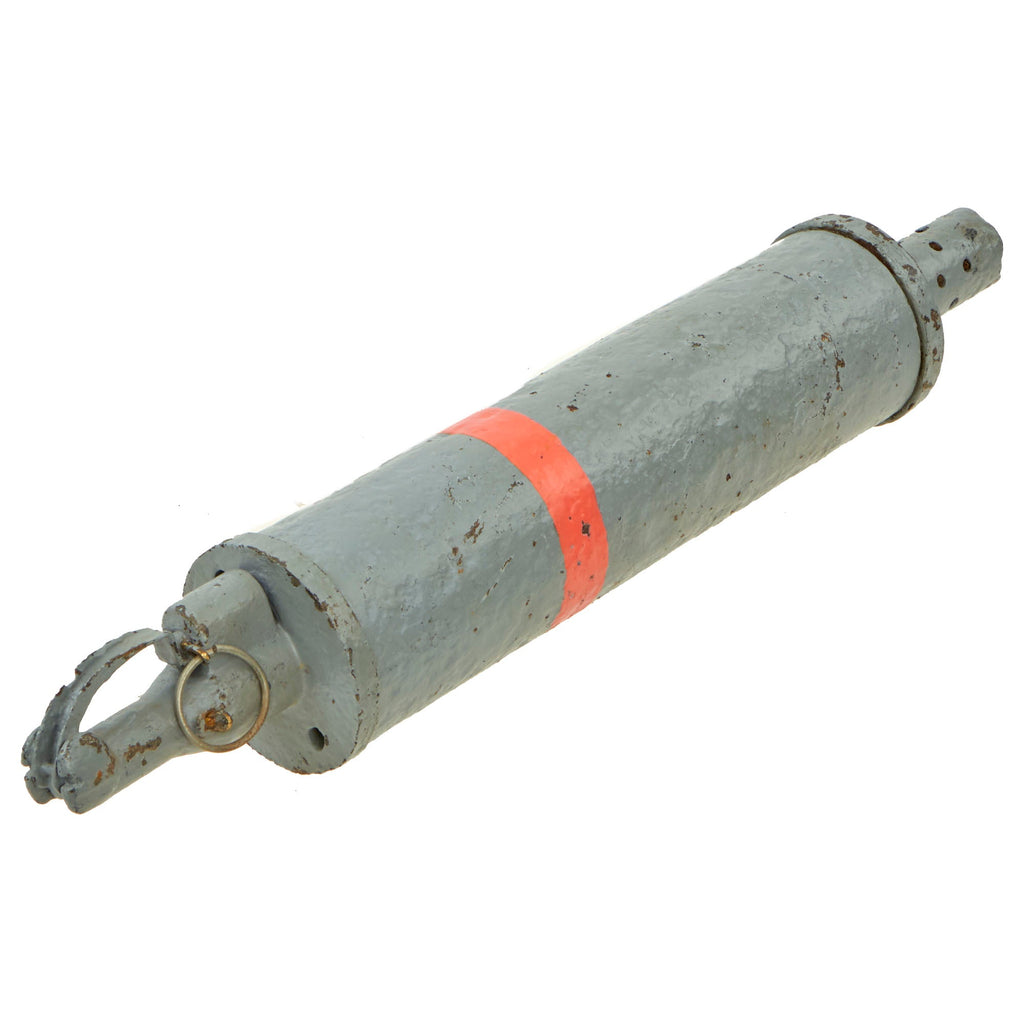Item Description
Original Item: Only one available. Totally inert and demilitarized according to BATF guidelines with hollow body and inert fuse. This is a lovely "relic" condition round for the British WWI Stokes mortar, which be believe is a "high explosive" type canister round. These early mortars were made in various different configurations, which changed as the war went on. Unlike later designs these do not have any fins on the back, for stabilization, making it definitely a very primitive design. The front fuse has TWO pull pins that must be removed in order to arm it. Measures approximately 18 1/2 inches in length.
Not available for Export.
Condition is very good, considering that it is almost certainly a battlefield pickup or ground dug example. It was disarmed, cleaned, and repainted, which covered a lot of the rust, though it is still apparent through the finish. Both the bottom and top ends of the tube unscrew to show the empty internal explosives chamber.
A nice repainted relic example of a hard to find piece of WWI British ordnance, ready to display!
The Stokes Mortar was a British trench mortar designed by Sir Wilfred Stokes KBE that was issued to the British and U.S. armies, as well as the Portuguese Expeditionary Corps, during the latter half of the First World War. The 3-inch trench mortar is a smooth-bore, muzzle-loading weapon for high angles of fire. Although it is called a 3-inch mortar, its bore is actually 3.2 inches or 81 mm.
The Stokes mortar was a simple weapon, consisting of a smoothbore metal tube fixed to a base plate (to absorb recoil) with a lightweight bipod mount. When a mortar bomb was dropped into the tube, an impact sensitive primer in the base of the bomb would make contact with a firing pin at the base of the tube, and ignite the propellant charge in the base, launching the bomb towards the target. The warhead itself was detonated by an impact fuse on reaching the target.
The barrel is a seamless drawn-steel tube necked down at the breech or base end. To the breech end is fitted a base cap, within which is secured a firing pin protruding into the barrel. The caps at each end of the bomb cylinder were 81 mm diameter. The bomb was fitted with a modified hand grenade fuse on the front, with a perforated tube containing a propellant charge and an impact-sensitive cap at the rear.
Range was determined by the amount of propellant charge used and the angle of the barrel. A basic propellant cartridge was used for all firing, and covered short ranges. Up to four additional "rings" of propellant were used for incrementally greater ranges. The four rings were supplied with the cartridge and gunners discarded the rings that were not needed.
One potential problem was the recoil, which was "exceptionally severe, because the barrel is only about 3 times the weight of the projectile, instead of about one hundred times the weight as in artillery. Unless the legs are properly set up they are liable to injury".
A modified version of the mortar, which fired a modern fin-stabilized streamlined projectile and had a booster charge for longer range, was developed after World War I; this was in effect a new weapon.
- This product is not available for international shipping.
Totally inert, cannot be converted to an explosive device, not available for export. This item is completely legal within the USA. International Military Antiques, Inc observes all Federal, State and Local laws. Everything for sale on ima-usa.com is completely legal to own, trade, transport and sell within the United States of America.
All deactivated ordnance sold by IMA, Inc is engineered to be inoperable according to guidelines provided by the US Bureau of Alcohol, Tobacco, Firearms and Explosives (BATF).
- Not eligible for payment with Paypal or Amazon









